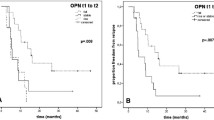Abstract
Objective
To investigate the relationship between postoperative metastasis and circulating levels of osteopontin in non-small cell lung cancer (NSCLC).
Methods
The expression of osteopontin mRNA were detected with RT-PCR technique. The circulating levels of osteopontin were measured through ELASA in 46 NSCLC cases that had not been received any anti-cancer treatment at the time of sampling. The tissues from fifteen patients with benign pulmonary diseases were studied as control group.
Results
The overall median mRNA expression level of osteopontin was approximately 70-fold higher in tumor tissues than in matched normal lung tissues (P<0.001). Over-expression of osteopontin mRNA was significantly associated with clinical stage (P=0.009). Advanced disease states had higher circulating level of osteopontin (stage I+II versus stage III+VI). In multivariate analysis, stage was the only independent factor influencing circulating levels of osteopontin. All patients were followed up for 12 months, 2 of the 46 patients with both osteopontin mRNA expression and elevated plasma osteopontin levels had local recurrence and 10 had distant metastasis. There was a significant difference in the osteopontin levels between metastasis group and non-metastasis group.
Conclusion
Preoperative plasma levels of osteopontin are significantly associated with post-operative metastasis in advanced NSCLC.
Similar content being viewed by others
References
Donati V, Boldrini L, Dell’Omodarme M, et al. Osteopontin expression and prognostic significance in non-small cell lung cancer. Clin Cancer Res 2005; 11:6459–6465.
Chan DC, Earle KA, Zhao TL, et al. Exisulind in combination with docetaxel inhibits growth and metastasis of human lung cancer and prolongs survival in athymic nude rats with orthotopic lung tumors. Clin Cancer Res 2002; 8:904–912.
Bogenrieder T, Herlyn M. Axis of evil: molecular mechanisms of cancer metastasis. Oncogene 2003; 22:6524–6536.
Tuck AB, Arsenault DM, O’Malley FP, et al. Osteopontin induces increased invasiveness and plasminogen activator expression of human mammary epithelial cells. Oncogene 1999; 18:4237–4246.
Le QT, Chen E, Salim A, et al. An evaluation of tumor oxygenation and gene expression in patients with early stage non-small cell lung cancers. Clin Cancer Res 2006; 12:1507–1514.
Hirama M, Takahashi F, Takahashi K, et al. Osteopontin overproduced by tumor cells acts as a potent angiogenic factor contributing to tumor growth. Cancer Lett 2003, 198:107–117.
Mountain CF. Revision in the international system for staging lung cancer. Chest 1997; 111:1710–1717.
Sodek J, Ganss B, McKee MD. Osteopontin. Crit Rev Oral Biol Med 2000; 11:279–303.
Reinholt FP, Hultenby K, Oldberg A, et al. Osteopontin — a possible anchor of osteoclasts to bone. Proc Natl Acad Sci USA 1990; 87: 4473–4475.
Giachelli CM, Steitz S. Osteopontin: a versatile regulator of inflammation and biomineralization. Matrix Biol 2000;19:615–622.
Shijubo N, Uede T, Kon S, et al. Vascular endothelial growth factor and osteopontin in tumor biology. Crit Rev Oncod 2000; 11:135–146.
Denhardt DT, Noda M, O’Regan AW, et al. Osteopontin as a means to cope with environmental insults: regulation of inflammation, tissue remodelling, and cell survival. J Clin Invest 2001; 107:1055–1061.
Geissinger E, Weisser C, Fischer P, et al. Autocrine stimulation by osteopontin contributes to antiapoptotic signalling of melanocytes in dermal collagen. Cancer Res 2002; 62:4820–4828.
Xie Y, Sakatsume M, Nishi S, et al. Expression, roles, receptors, and regulation of osteopontin in the kidney. Kidney Int 2001; 60:1645–1657.
Thalmann GN, Sikes RA, Devoll RE, et al. Osteopontin: possible role in prostate cancer progression. Clin Cancer Res 1999; 5:2271–2277.
Agrawal D, Chen T, Irby R, et al. Osteopontin identified as lead marker of colon cancer progression, using pooled sample expression profiling. J Natl Cancer Inst 2002; 94:513–521.
Hu Z, Lin D, Yuan J, et al. Overexpression of osteopontin is associated with more aggressive phenotypes in human non-small cell lung cancer. Clin Cancer Res 2005; 11:4646–4652.
Coppola D, Szabo M, Boulware D, et al. Correlation of Osteopontin protein expression and pathological stage across a wide variety of tumor histologies. Clin Cancer Res 2004, 10:184–190.
Tuck AB, Hota C, Chambers AF. Osteopontin (OPN)-induced increase in human mammary epithelial cell invasiveness is urokinase (uPA)-dependent. Breast Cancer Res Treat 2001; 70:197–204.
Schorge JO, Drake RD, Lee H, et al. Osteopontin as an adjunct to CA125 in detecting recurrent ovarian cancer. Clin Cancer Res 2004; 10:3474–3478.
Wong TS, Kwong DL, Sham J, et al. Elevation of plasma osteopontin level in patients with undifferentiated nasopharyngeal carcinoma. Eur J Surg Oncol 2005; 31:555–558.
Rudland PS, Platt-Higgins A, EI-Tanani M, et al. Prognostic significance of the metastasis-associated protein osteopontin in human breast cancer. Cancer Res 2002; 62:3417–3427.
Isa S, Kawaguchi T, Teramukai S, et al. Serum osteopontin levels are highly prognostic for survival in advanced non-small cell lung cancer: results from JMTO LC 0004. J Thorac Oncol 2009; 4:1104–1110.
Mack PC, Redman MW, Chansky K, et al. Lower osteopontin plasma levels are associated with superior outcomes in advanced non-small cell lung cancer patients receiving platinum-based chemotherapy: SWOG Study S0003. J Clin Oncol 2008; 26:4771–4776.
Chang YS, Kim HJ, Chang J, et al. Elevated circulating level of osteopontin is associated with advanced disease state of non-small cell lung cancer. Lung Cancer 2007; 57:373–380.
Author information
Authors and Affiliations
Corresponding author
Rights and permissions
About this article
Cite this article
Liang, Y., Li, H., Hu, B. et al. Elevated circulating levels of osteopontin are associated with metastasis in advanced non-small cell lung cancer. Chin. J. Cancer Res. 23, 64–68 (2011). https://doi.org/10.1007/s11670-011-0064-9
Received:
Accepted:
Published:
Issue Date:
DOI: https://doi.org/10.1007/s11670-011-0064-9




